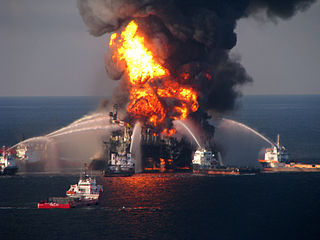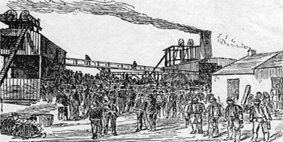
Nanaimo is a city of about 100,000 on the east coast of Vancouver Island, in British Columbia, Canada. "The Harbour City" was previously known as the "Hub City", which was attributed to its original layout design with streets radiating from the shoreline like the spokes of a wagon wheel, and to its relatively central location on Vancouver Island. Nanaimo is the headquarters of the Regional District of Nanaimo.

Saysutshun Provincial Park, formally known as Newcastle Island Marine Provincial Park, is a provincial park located on a small island off the coast of Nanaimo, British Columbia, Canada.
A mining accident is an accident that occurs during the process of mining minerals or metals. Thousands of miners die from mining accidents each year, especially from underground coal mining, although accidents also occur in hard rock mining. Coal mining is considered much more hazardous than hard rock mining due to flat-lying rock strata, generally incompetent rock, the presence of methane gas, and coal dust. Most of the deaths these days occur in developing countries, and rural parts of developed countries where safety measures are not practiced as fully. A mining disaster is an incident where there are five or more fatalities.
Benxihu (Honkeiko) Colliery, located in Benxi, Liaoning, China, was first mined in 1905. Originally an iron and coal mining project under joint Japanese and Chinese control, the mine came under predominantly Japanese control. In the early 1930s, Japan invaded the northeast of China, and Liaoning province became part of the Japanese-controlled puppet state of Manchukuo. During the Second Sino-Japanese War, the Japanese forced Chinese labourers—some of whom had been captured from local military organizations—to work the colliery under very poor conditions. Food was scarce and workers did not have sufficient clothing. Working conditions were harsh, and diseases such as typhoid and cholera flourished due to poor sanitation and water supplies. Typically miners worked 12-hour shifts or longer. The Japanese controllers were known to beat workers with pick handles, and the perimeter of the mine was fenced and guarded. Many describe the conditions as slave labour.
Cumberland is an incorporated village municipality east of Perseverance Creek, near the east coast of central Vancouver Island, British Columbia. The Comox Valley community is west of BC Highway 19 and is by road about 105 kilometres (65 mi) northwest of Nanaimo and 10 kilometres (6 mi) southwest of Courtenay.

Mining in Australia has long been a significant primary sector industry and contributor to the Australian economy by providing export income, royalty payments and employment. Historically, mining booms have also encouraged population growth via immigration to Australia, particularly the gold rushes of the 1850s. Many different ores, gems and minerals have been mined in the past and a wide variety are still mined throughout the country.

Harewood is the name of a lake and a plain of the Canadian province of British Columbia. It is located in Nanaimo, on the east coast of Vancouver Island. Its geographical coordinates are 49°08′N123°57′W The name has been in use since at least 1913, when Harewood referred to a small mining village in the area, no longer existing, having been overtaken by Nanaimo. The mine was owned in part by the seventh son of Henry Lascelles, 3rd Earl of Harewood who served on the BC coast as captain of the gunboat HMS Forward and set up the Harewood Coal Mining Company to work deposits he acquired.
Wellington, formerly a separate district and town, is a neighbourhood of north Nanaimo, on the east coast of southern Vancouver Island, British Columbia.
The Scofield Mine disaster was a mining explosion that occurred at the Winter Quarters coal mine on May 1, 1900. The mine was located at 39°42′57″N111°11′17″W near the town of Scofield, Utah. In terms of life lost, it was the worst mining accident at that point in American history. The explosion is also a key element in the plot of the Carla Kelly novel My Loving Vigil Keeping.

Energy resources bring with them great social and economic promise, providing financial growth for communities and energy services for local economies. However, the infrastructure which delivers energy services can break down in an energy accident, sometimes causing considerable damage. Energy fatalities can occur, and with many systems deaths will happen often, even when the systems are working as intended.
Extension is an unincorporated community near the east coast of southern Vancouver Island, British Columbia. The location off BC Highway 19 is about 107 kilometres (66 mi) by road northwest of Victoria, and 10 kilometres (6 mi) south of Nanaimo.
Nanaimo, British Columbia had four Chinatown sites beginning in the 1800s.

Mine safety is a broad term referring to the practice of controlling and managing a wide range of hazards associated with the life cycle of mining-related activities. Mine safety practice involves the implementation of recognised hazard controls and/or reduction of risks associated with mining activities to legally, socially and morally acceptable levels. While the fundamental principle of mine safety is to remove health and safety risks to mine workers, mining safety practice may also focus on the reduction of risks to plant (machinery) together with the structure and orebody of the mine.
Lynne Bowen is a Canadian non-fiction writer, historian, professor, and journalist, best known for her popular historical books about Vancouver Island and British Columbia. Over the years, Bowen has won awards such as the Eaton's British Columbia Book Award (1983), the Lieutenant Governor's Medal for Writing British Columbia History (1987), and the Hubert Evans Non-Fiction Prize (1993).
The Protection Island mining disaster killed 16 miners and occurred on Protection Island near Nanaimo, British Columbia, Canada. The disaster occurred at 7:10 a.m. on September 10, 1918 when the hoisting cable frayed on the cab that was lowering miners into the mine. Six other cabs of 16 miners each had preceded the cab which fell 300 feet into the mine. The bodies of the miners were mangled to the point where personal effects were used to identify the victims. It was later determined that salt water in the air had caused corrosion of the cable leading to the accident.











